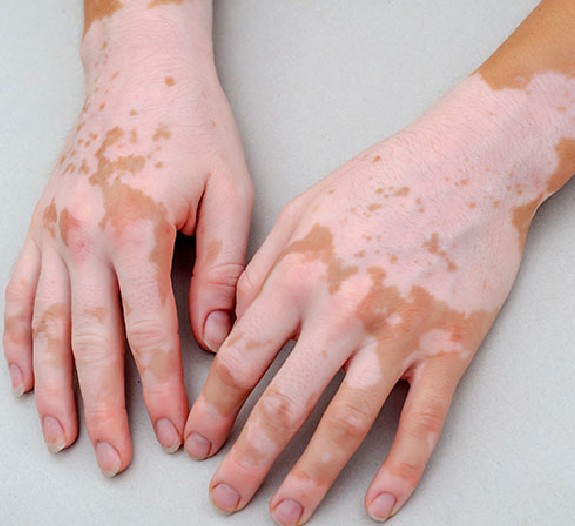
Causes
The destruction of pigment-forming cells known as melanocytes causes vitiligo. The exact cause of vitiligo remains unknown, some conditions that contribute to vitiligo are mentioned below:
1. Albinism
It is a rare genetic disorder that leads to loss of color of the skin, hair and the eyes.
2. Alopecia Areata
It is an auto-immune disease that leads to hair loss in patches. It can also lead to vitiligo.
3. Hashimoto’s Thyroid
It is also an auto-immune disease that leads to discoloration of the skin. This also makes the skin more sensitive.
4. Other Factors
Hereditary reasons and some environmental factors such as sunburn and exposure to certain chemicals also contribute to vitiligo.
Symptoms
- Patchy loss of skin color (skin becomes light or white).
- Change in color or loss of color in the retina of the eyeball.
- Loss of color inside the mucous membrane.
- Greying or whitening of the hair present on the scalp, beard, eyebrows.
This depigmentation or white patches are more common in areas of the skin which are exposed to the sun. The patches may be on the hands, feet, arms, face, and lips.
Other common areas for Vitiligo are
- Armpits and groin (where the leg meets the body)
- Around the mouth
- Eyes
- Nostrils
- Navel
- Genitals
- Rectal areas
Complications
If left untreated, the patient can have an increased risk of:
- Sunburn
- Social or psychological distress
- Hearing loss
- Cancer of the skin
- Certain eye problems
Treating Vitiligo
Vitiligo is described as a cosmetic problem; rather it is a health issue that requires immediate clinical attention. Several remedies can aid in making the condition less visible, and some of them include:
Using sunscreen regularly: Using sunscreen protects the lighter areas of the skin, which are more sensitive to the sun rays. Since there are several types of sunscreen available, consulting with a dermatologist is safe before choosing a sunscreen.
Phototherapy using UVB light: Controlled exposure to UVB light is an effective treatment measure for vitiligo. UVB phototherapy can also be used when there are numerous white spots all over the body. Since this is a full-body treatment, it is performed in a hospital. You will need around 2 to 3 visits in a week, and the time required for the treatment will also be longer. This treatment, together with other treatments, can have a substantial effect on vitiligo, but it is always necessary to have realistic expectations about the treatment.
Skin camouflage: Those who are suffering from mild instances of vitiligo can obtain benefits from the camouflage treatment done with cosmetic creams to cover up the white patches. A wide range of creams is available in a various range of skin color so that they can easily match with the affected individual skin tone.
Laser therapy: People suffering from limited, stable patches of vitiligo can immensely obtain benefit from the Laser therapy technique. It is a safe and effective way to treat this condition. It may not be very cost-effective, but the results are totally worth and promising. A patient is treated twice a week, and it takes about 24-48 sessions to treat the localized lesions of vitiligo.
It is best to start the treatment of vitiligo as soon as possible to manage the condition to a substantial extent. So, visit a dermatologist today and understand which treatment option would work best for you. In case you have a concern or query, you can always consult an expert & get answers to your questions!
 Whatsapp
Whatsapp Facebook
Facebook Twitter
Twitter Instagram
Instagram Linkedin
Linkedin Pinterest
Pinterest